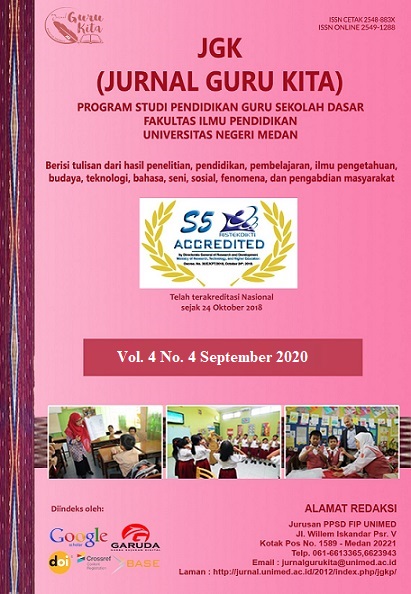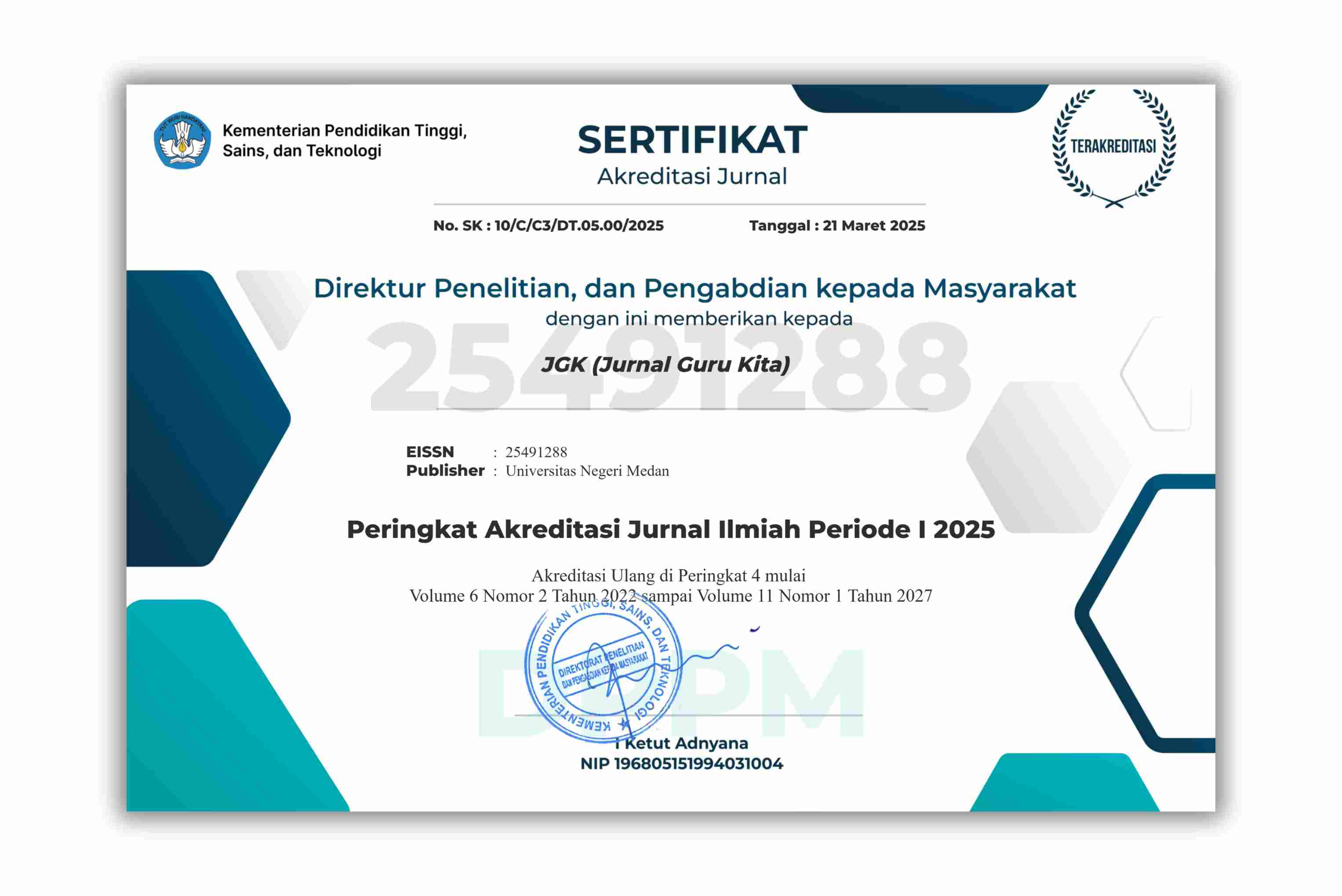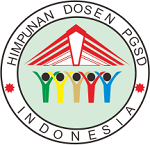GAYA KELEKATAN DAN KEMAMPUAN BELAJAR KELOMPOK KOLABORATIF PADA MAHASISWA DI PERKULIAHAN DARING SELAMA MASA PENDEMI COVID-19
DOI:
https://doi.org/10.24114/jgk.v5i4.27817Keywords:
Gaya Kelekatan, Kerja Kelompok KolaboratifAbstract
Abstract: The Attachment Styles and Students™ Collaborative Group Work Ability on Online Learning during The Covid-19 Pandemic. This Study was conducted to determine the effect of the four types of attachment styles on students™ collaborative group work ability during online learning. A total of 87 students from Universitas Negeri Medan completed self-administered questionnaires and the data were analysed using the multiple regression analysis (MRA). According to the findings, the four attachment styles (Secure, Anxious, Preoccupied, and Dismissing) were found to have 61% impact on the student's collaborative group work ability. The secure attachment style has the greatest influence, accounting for 45.2 %. Meanwhile, based on the results of the partial t-test, it is known that the anxious attachment style has a minimal impact on students' collaborative group work. Keywords: Attachment Style, Collaborative Group Work Abstrak: Gaya Kelekatan dan Kemampuan Belajar Kelompok Kolaboratif pada Mahasiswa di Perkuliahan Daring selama Masa Pendemi Covid-19. Penelitian ini dilakukan untuk mengetahui pengaruh ke-empat tipe kelekatan terhadap kemampuan belajar kolaboratif mahasiswa selama pembelajaran daring. Subjek Penelitian ini adalah mahasiswa Universitas Negeri Medan yang mengikuti perkulian daring selama masa pendemi Covid-19. Sebanyak 87 mahasiswa mengisi kuesioner penelitian dan hasil data dianalisis dengan menggunakan analisis regresi linier berganda. Hasil penelitian menunjukkan bahwa empat gaya kelekatan (aman, cemas, terikat dan lepas) berpengaruh secara simultan terhadap kemampuan belajar kelompok kolaboratif mahasiswa sebesar 61%. Gaya kelekatan aman memiliki pengaruh paling dominan yaitu sebesar 45,2%. Sedangkan berdasarkan hasil uji-t parsial diketahui bahwa gaya kelekatan cemas tidak memiliki pengaruh terhadap kemampuan belajar kelompok kolaboratif sebesar. Kata Kunci: Gaya Kelekatan, Kerja Kelompok KolaboratifReferences
Bartholomew, K. & Horowitz. (1991). Attachment styles among young adults: a test of a four category model. Journal of Personality and Social Psychology, 61 (2): 226-224
Biasutti, M. (2011). The student experience of a collaborative e-learning university module. Computers and Education, 57, 861-872.
Bigenho, C. W. (2011). Student reflections as artifacts of self-regulatory behaviors for learning: A tale of two courses (Unpublished doctoral dissertation). University of North Texas, Denton, TX.
Donald, R. C., Jenkins, D. B., & Metcalf, K. K. (2006). The act of teaching.
Gafni, R., & Geri, N. (2010). Time management: Procrastination tendency in individual and collaborative tasks. Interdisciplinary Journal of Information, Knowledge, and Management, 5, 115-15
Gerlach, J. M. (1994). Is This Collaboration?. New directions for teaching and learning, 59, 5-14.
Hil, S. and Hill, T. (1993). The Collaborative Classroom. A Guide to Cooperative Learning. Amadale, Vic: Eleanor Curtin Publishing
Hofstra, J., & Oudenhoven, V. J. P. (2004). Ontwikkelingenevaluatic van de Hechtingsstijlvragenlijst (HSL)(Development and Evaluation of the Attachment Styles Questionnaire (ASQ)). NederlandsTijdschriftvoor de Psychologic, 58, 95-102.
Iftinan, Q. (2021). Hubungan Antara Kelekatan Orang Tua (Ibu) Terhadap Kecerdasan Emosi Pada Siswa Kelas XII Jurusan IPA SMAN 01 Tumijajar Kabupaten Tulang Bawang Barat. JURNAL PSIMAWA, 4(1), 61-68.
Kobak, R. R., & Sceery, A. (1988). Attachment in late adolescence: Working models, affect regulation, and representations of self and others. Child development, 135-146.
Ku, H., Tseng, H. W., & Akarasriworn, C. (2013). Collaboration factors, teamwork satisfaction, and student attitudes toward online collaborative learning. Computers in Human Behavior, 29, 922-229.
Lavy, S. (2017). Who benefits from group work in higher education? An attachment theory perspective. Higher Education, 73(2), 175-187.
Liu, S., Joy, M., & Griffiths, N. (2010). Students™ perceptions of the factors leading to unsuccessful group collaboration. Paper presented at 2010 IEEE 10th International Conference on Advanced Learning Technologies, Sousse, Tunisia.
Menteri Pendidikan dan Kebudayaan Republik Indonesia. (2020). Surat Edaran Mendikbud Nomor 36962/MPK.A/HK/2020 tentang Pembelajaran secara Daring dan Bekerja dari Rumah dalam Rangka Pencegahan Penyebaran Corona Virus Disease (COVID- 19). Jakarta: Kemendikbud.
Mikulincer, M., & Shaver, P. R. (2007). Attachment patterns in adulthood: Structure, dynamics, and change. New York: Guilford Press.
Rom, Ež & Mikulincer, M. (2003). Attachment theory and group processes: The association between attachment style and group”related representation, goals, memories, and functioning. Journal of Personality and Social Psychology, 84, 1220-1235.
Sutcliffe, J., (2002). Baby Bonding, Membentuk Ikatan Batin dengan Bayi. Jakarta: Taramedia & Restu Agung
Downloads
Published
How to Cite
Issue
Section
License
Authors published with the JGK (Jurnal Guru Kita) agree to the following terms:
- Authors retain copyright and grant the journal the right of first publication with the work simultaneously licensed under a Creative Commons Attribution License (CC BY-SA 4.0) that allows others to share the work with an acknowledgment of the work's authorship and initial publication in this journal.
- Authors are able to enter into separate, additional contractual arrangements for the non-exclusive distribution of the journal's published version of the work (e.g., post it to an institutional repository or publish it in a book), with an acknowledgment of its initial publication in this journal.
- Authors are permitted and encouraged to post their work online (e.g., in institutional repositories or on their website) prior to and during the submission process, as it can lead to productive exchanges, as well as earlier and greater citation of published work. (See The Effect of Open Access)

























